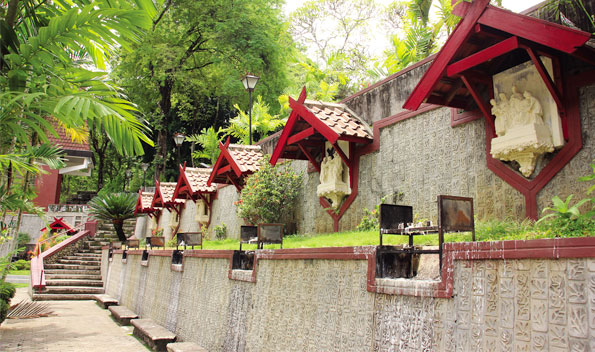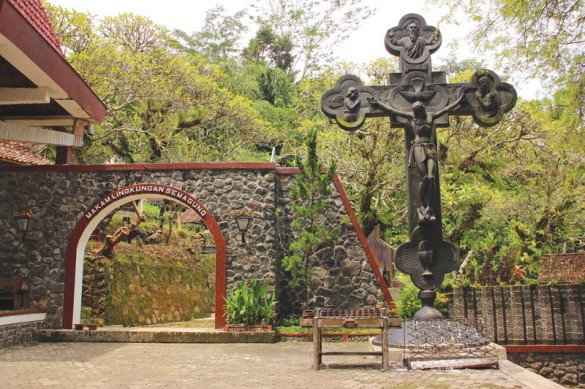Java is described by many as a historically rich hub of spiritual devotion and diversity. Christians in rural Java may not deck their halls with boughs of holly or hang up their stockings for Father Christmas. But like other religions in Java, Christianity and its celebrations have been finely repackaged in a local form like no other.
Tucked a 30-minute drive from the massive Buddhist monument Borobudur, within the borders of the Royal Jogjakarta Sultanate, is a prayer garden the Javanese Catholics of Kulon Progo proudly call home; Gua Maria Sendang Sono.
Dubbed “Lourdes in Yogyakarta”, Sendang Sono features stations of the cross (prayer altars depicting the passion of the Christ), a grotto for lighting candles in prayers to Mother Mary, several al fresco chapels and a holy spring whose water is believed to have healing properties.
Sendang Sono was founded in 1904 when a local Javanese farmer, Barnabas Sarikromo, converted to Catholicism and got baptised on Pentecost day. Before this, Sarikromo suffered a mysterious disease that plagued his legs with foul-smelling wounds. In meditation, Sarikromo was inspired to travel to Muntilan where he met Dutch priest Frans van Lith. The priest nursed Sarikromo back to health and introduced him to the Catholic faith.
Since Sarikromo was healed, he passionately told fellow villagers of “the healing power of Jesus Christ” and assembled them for prayers and Eucharist celebrations. By December 1904, 173 locals were baptised in the spring (“sendang”) by the sono trees (Pterocarpusindicus). This event marked the start of the spread of Catholicism in Yogyakarta and Central Java.
Later in the 1929, Austrian priest Fr J. B. Prennthaler blessed the opening of the sacred grotto devoted to Mary. The 180-cm tall teakwood statue of Mary in the Sendang Sono grotto was imported from Denmark, manually carried by 30 men on foot across the Menoreh hills.
The current look of Sendang Sono was designed by Fr Yusuf Bilyarta Mangunwijaya (“Romo Mangun”). The architecture follows the natural contours of the local hills and display a fine blend between Javanese and classical European styles.
But far before Catholicism spread in Kulon Progo, Sendang Sono has long been a sacred place in other contexts. In previous centuries, Sendang Sono used to be the resting place of Buddhist monks who travelled by foot from Borobudur to Mendut. Prior to the introduction of Mary, locals adherents to the indigenous Kejawen faith previously believed that the sono trees were haunted by the spirit couple Dewi Lantamsari and Den Bagus Samijo.
“We appreciate culture as the self-expression of the local people. Before Catholicism was introduced, people here already had their own symbols of salvation. So when we encourage locals to revisit those traditional symbolisms as we discuss Catholic ideas, we become more deeply rooted,” said Fr Wahadi from the Promasan parish, of which Sendang Sono is part.
Becoming deeply rooted in the local culture also means that agricultural affairs have long been an important part of the Promasan parish.“Ever since the parish was established, the Fathers in Promasan have had great concern for community development,” said Fr Wahadi.
The parish’s initiatives since the 1950s have included the introduction of clove in local plantations, loaning cattle to local farmers on an alternate basis, and establishing a credit union offering soft loans to local enterprises. The parish also runs two local primary schools that are tuned into the local agriculturally-centred culture.
Asked why the church takes such great measures in developing the local agriculture and education, Fr Wahadi said, “Locals here deserve to be empowered. The infrastructure is quite basic, the streets get puddled when it rains, and transportation is scarce. Agricultural patterns here are also subject to the weather – the land is dry due to lack of irrigation. Socioeconomically speaking, this is a tough place to live compared to urban Yogyakarta.”
As the generations pass, the youth of Kulon Progo are showing signs of progress thanks to the work of the Catholic church. Many have travelled to Yogyakarta city and beyond to pursue higher education, and become successful professionals and businesspeople. On the downside, many leave for good to lead modern lives elsewhere instead of coming back to develop the village from which they come.
But when they do come home for a visit – for instance at Christmas time – there seems to be a sense of pride in what young people from rural Kulon Progo can achieve. The holiday season then becomes an opportunity for the youth – and other locals who may not be as young – to reconnect to their roots.
Christmas and other Christian celebrations at Sendang Sono have been celebrated with hymns accompanied by the gamelan, gospel wayang performances, jathilan, and even Catholic versions of salawat (prayer greetings to mark the seven daily Liturgy of the Hours, influenced by Islamic greetings to Muhammad during the five daily prayer times).
A Nativity wayang production was last held in 2012, performed by head puppeteer Fr Krijo who is both an ordained priest and a royal abdidalem in the Yogyakarta Keraton. Unfortunately there have been no such plans yet for this year, and Fr Wahadi predicts that such productions of the Javanese performing arts will become scarcer in the future.
“Looks like we’ll simply celebrate Christmas with the regular church liturgy this year,” said Fr Wahadi. Additionally, the local parish plans to do some charity work such as building houses, aiding medical care, or distributing basic foodstuffs for the congregation members in need.
That said, Fr Wahadi mentioned a Catholic salawat performed in Sendang Sono just the night before I met him. While the schedules of such performances are rarely published and hard to predict, there is still a chance to see them if you happen to visit on a lucky day.
An inn managed by the local parish is available for visitors to Sendang Sono in exchange for voluntary donations. By staying at this inn, you can enjoy the clear star-studded night skies of Kulon Progo, wake up to the serene surroundings of the Menoreh hills, and celebrate the early morning Eucharist at 6:30 AM.
Many Catholics find Sendang Sono a great place to draw closer to God and strengthen their faith. And for non-Catholics like myself, I’ve found it to be a beautiful place to find inner peace and reflect on the things I’m thankful for in life. To me, that sounds like a great place to be this Christmas.






